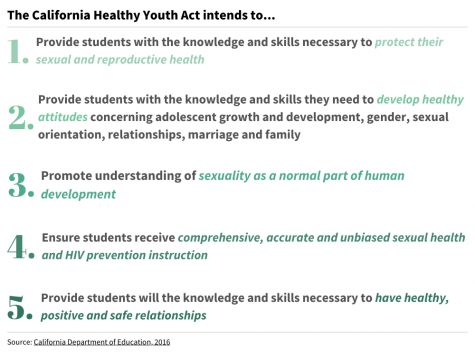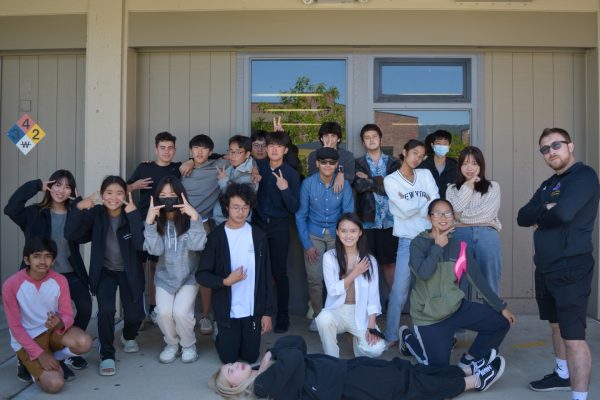Expanding sex education
Examining sex education at MVHS in comparison to schools nationwide
Every spring, Biology teachers present a four-week, comprehensive sex education curriculum to freshmen. This curriculum ― dubbed Sexual Health and Relationships Education, or SHARE ― covers topics from gender identity and sexual orientation to communication skills and healthy relationships.
Though many California schools have an extensive sexual health unit like MVHS, legislation has helped ensure that schools across the state provide a comprehensive unit to all students. Passed in 2016, the California Healthy Youth Act (CHYA) has upped sexual health education standards to be medically accurate and more inclusive of all identities.
While legislation like CHYA was instrumental in encouraging schools to teach accurate and comprehensive sex education, other states are far from adopting the same measures.
According to Guttmacher Institute, only 39 states mandate sex education and/or HIV education. Of these, 28 states stress the importance of abstinence and 19 oppose premarital sex in their curriculum. These statistics are worrisome, as research studies have shown that failing to educate students on safe sex, withholding medically accurate information and excluding many identities increases the number of individuals who engage in unhealthy sexual behavior.
The limited sex education taught in other states can be attributed to the politicization of sexual health. Rather than focusing on providing students accurate information so they are educated on healthy sex and relationships, schools’ guidelines adhere to the political beliefs of state residents — in more liberal states, sexual health curriculm tends to be more extensive, whereas in more conservative states, it is limited in its reach, if present at all. Politicizing sex education is a tremendous issue because receiving sufficient sex education is directly linked to safety and better health, as explained by Planned Parenthood.
This is where legislation, like the CHYA, can play an important role. By providing guidance and resources on furthering sex education, sexual health activists can combat the politicization of sexual health topics and provide schools, teachers and students with the support, resources and instruction they need.
While MVHS was already following most of the CHYA’s guidelines according to Biology teacher Lora Lerner, the bill allowed Fremont Union High School District to establish more comprehensive standards for sex education. After CHYA was passed, FUHSD contracted with Health Connected, an outside organization that provides many resources in helping teachers cover topics they may be uncomfortable with initially.

Despite being more comprehensive than other schools across the country, MVHS’s SHARE unit still has room for improvement. As scientific knowledge about sexual health evolves and certain topics like sexual assault and consent are pushed to the forefront of conversation in our community, it’s important that we continually update our sex education curriculum.
To address our ever-changing needs and understanding of sexual health, MVHS students should receive access to sex education resources throughout their high school career as opposed to just freshman year.
While the SHARE unit in Biology provides students a great opportunity to learn and ask questions about sexual health, many students may not always be comfortable asking such questions in front of their peers or have even thought about sexuality yet.
In some cases, students learn about sex education only in school environments and aren’t able to discuss these topics with their families due to cultural norms. However, if schools create a safe space for students to explore their sexuality and promote the idea that sexual health is a normal part of human development, students may become more comfortable discussing these topics and asking relevant questions.
While Physiology, a science course offered to juniors and seniors, revisits sex education, not all students take the class and get to cover this content again. MVHS must find ways to share resources ― such as presentations and websites ― that reflect our evolving understanding of sexual health with students of all grades and provide them a space to ask any questions they have.
One potential solution is establishing student- and teacher-led Advisory lessons about these topics. By collaborating on these lessons, students can provide Biology teachers insight on what they think are relevant or wish they had learned more about.
Additionally, MVHS could create anonymous feedback and question forms for upperclassmen, which would give students a space to learn about sexual health topics beyond freshman year. All teachers could include information about popular questions in their Advisory lessons and the Biology teachers could continue to incorporate this content into the freshman SHARE unit.
When it comes to sex education, we should pride ourselves on how comprehensive our curriculum is. However, this doesn’t mean MVHS shouldn’t keep looking for ways to improve ― whether it be by adding Advisory lessons on sexual health or integrating feedback from upperclassmen into our curriculum.
Students carry sexual health and relationship skills with them for the rest of their lives, so it’s crucial that the education they receive on these topics is as comprehensive as it can be. Even though it’s a difficult task to improve sex education nationwide, we can play our part by bettering our curriculum and continuing to support our students.







